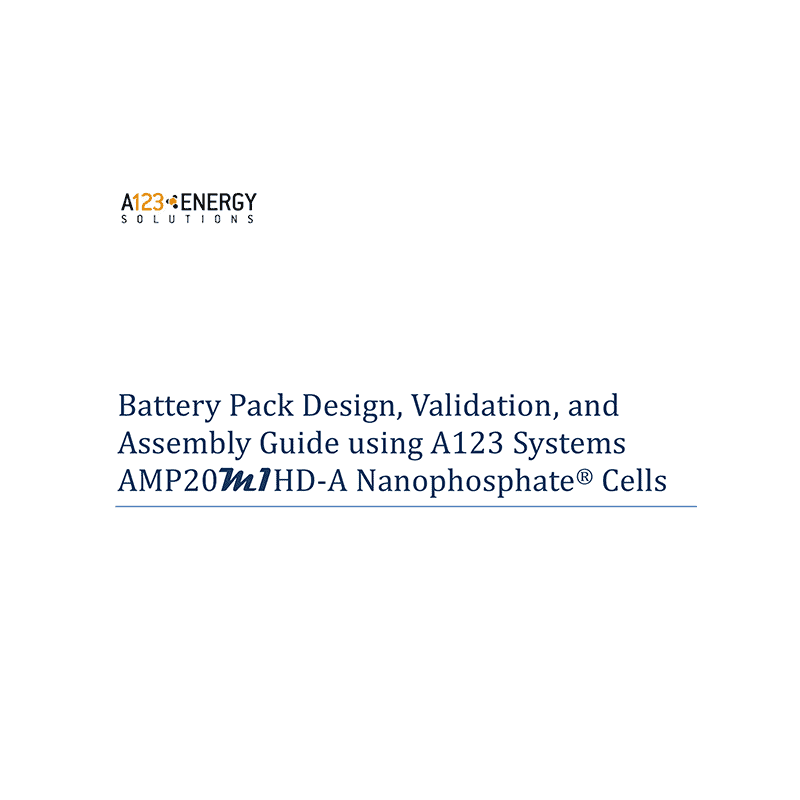Battery Pack Design, Validation, and Assembly Guide using A123 Systems AMP20M1HD-A Nanophosphate Cells
Download PDF battery pack design, validation, and assembly guide using A123 Systems AMP20M1HD-A nanophosphate cells (EN) 71 pages 493005-002 2014 zip
Description
This PDF design, validation, and assembly guide is for the A123 Systems AMP20M1HD-A Nanophosphate Lithium-ion Battery.
About the Item
Battery Pack Design, Validation, and Assembly Guide using A123 Systems AMP20M1HD-A Nanophosphate Cells
Creating a well designed battery pack requires many considerations. The scope of this guide is to outline the unique aspects of designing battery packs with A123 AMP20M1HD-A Nanophosphate cells. A123 Energy Solutions recommends the study of additional relevant documentation from appropriate sources before designing validating, and assembling battery packs with A123 Nanophosphate cells. This document may not be applicable to any cells not provided by A123.
Anyone involved in the design, use, or assembly of products that use A123 cells should read and understand this document.
The chapters in this guide are organized sequentially as they relate to design requirements that must be considered and understood before and during designing, validating, and assembling battery packs with A123 Nanophosphate cells.
This guide contains the following information:
– Chapter 1, Possible Dangers Involved with Handling Cells and Battery Packs – describes dangers involved with handling cells and battery packs.
– Chapter 2, Transportation, Storage and Recycling – describes regulations and laws required for transporting lithium-ion batteries or products containing them.
– Chapter 3, Nanophosphate Technology and Cell Characteristics – describes how Nanophosphate electrode technology influences power, safety, and cycle life performance.
– Chapter 4, Battery Pack Design – describes the various stages of battery pack design, covering aspects of A123 Energy cells, which may be different from other cells.
– Chapter 5, Summary of Battery Pack Testing – describes performance, abuse, and compliance testing.
– Chapter 6, Pack Manufacturing – describes the processes for cell incoming inspections, material handling and storage, and cell welding.
– Appendix A, Specifications – describes electrical, physical, and environmental specifications and maximum charge and discharge currents per cell
– Appendix B, Acronyms and Terminology – describes terms and acronyms used in this guide.
(PDF) DESIGN/VALIDATION/ASSEMBLY GUIDE (ENGLISH)
SUMMARY OF CONTENTS
PREFACE. About this document.
– Purpose of this document
– How to Use this Guide
– Conventions Used in this Guide
– Related Documents and Resources
Chapter 1. Possible Dangers Involved With Handling Cells and Battery Packs.
– Thermal Events
– Short Circuits
– Arc Flashes
– High Voltage
Chapter 2. Transportation, Storage and Disposal.
– Transporting Batteries
– Storing Batteries
– Battery Disposal
Chapter 3. Nanophosphate Technology and Cell Characteristics.
– Nanophosphate Technology
– Power
– Safety
– Life
Chapter 4. Battery Pack Design.
– Design Overview
– Configuration of Cells in a Battery Pack
– Battery Pack Structural Design
– Cell Protection
– Battery Pack Control (Monitoring and Management)
– Battery Pack Use
Chapter 5. Summary of Battery Pack Testing.
– Performance Testing
– Abuse Testing
– Compliance Testing
Chapter 6. Battery Pack Assembly.
– Incoming Cell Inspection
– Material Handling and Storage
– Cell Welding
Appendix A. Cell Specifications.
– AMP20M1HD-A General Specifications
Appendix B. Acronyms and Terminology
FIGURES
Figure 1 – 20Ah Prismatic cells discharge curves
Figure 2 – A123 20Ah Prismatic cells discharge curves at various temperatures
Figure 3 – 20Ah Prismatic cells cycle life (1C charge / 1C discharge rates)
Figure 4 – Capacity loss due to calendar aging
Figure 5 – Example of AMP20M1HD-A cells connected in series
Figure 6 – Cells connected in parallel
Figure 7 – Cycle life of the cell can be optimized by applying the proper pressure to the face of the cell and maintaining that throughout the life of the cell
Figure 8 – 20Ah cell thickness variation wrt SOC for three representative 20Ah cells
Figure 9 – Graph of the pressure vs. deflection of an example compliant pad, which may be used between 20Ah cells in a battery pack
Figure 10 – Pressure on cell face without compliant pad (left) and with compliant pad (right)
Figure 11 – Pressure map across the surfaces of each cell in a stack showing the results of a non-ideal but acceptable end-cap design
Figure 12 – Corner that will vent under extreme internal pressure
Figure 13 – Diagram of optional 20Ah cell cooling concept
Figure 14 – Individual cell fusing strategy
Figure 15 – Example cell fuse pattern in cell terminals
Figure 16 – Example of total system fusing strategy
Figure 17 – Battery pack with representative short circuit faults
Figure 18 – 20Ah Voltage vs. SOC at 23 deg C
Figure 19 – vSOC sensitivity to OCV error
Figure 20 – Temperature effects on OCV with respect to SOC
Figure 21 – 60s, 20A DCR measurements wrt SOC at various temperatures
Figure 22 – Battery voltage and current during recharge
Figure 23 – 20Ah Prismatic cell capacity degradation vs. time for various recharge rates
Figure 24 – Bus bar concept diagram and resulting welded cross sections
Figure 25 – Two types of bus bars ultrasonically bonded in the center to each other
Figure 26 – AMP20M1HD-A 20Ah cell dimensions
Figure 27 – Notes for Figure 26
TABLES
Table 1 – Steps required to transport a lithium ion battery
Table 2 – Nominal energy and ELC of A123 cells
Table 3 – US transportation classification of cells
Table 4 – US transportation classification of batteries
Table 5 – International transportation classification of cells
Table 6 – International transportation classification of batteries
Table 7 – International air transport (IATA) packaging and quantity restrictions (PI-965)
Table 8 – International air transport (IATA) packaging and quantity restrictions (PI-966 & PI-967)
Table 9 – Example histogram data showing product’s time at different temperatures
Table 10 – Charge current and voltage calculation examples
Table 11 – Performance tests
Table 12 – Abuse tests
Table 13 – Useful battery pack standards and their relevant applications
Table 14 – AMP20M1HD-A 20Ah cell specifications
Table 15 – Max continuous charge currents wrt temperature and SOC
Table 16 – Max 10s pulse charge currents wrt temperature and SOC
Table 17 – Max continuous discharge currents wrt temperature and SOC
Table 18 – Max 10s pulse discharge currents wrt temperature and SOC
Table 19 – Acronyms and Terminology Descriptions
Why download the Datasheet?
This guide provides information that may be useful for designing, validating, and assembling battery packs with A123 Nanophosphate cells. Reading it completely will address most questions you might have. You can download and save it for offline use, including viewing it on your device or printing it for your convenience if you prefer a paper version.
How to download the Datasheet?
Download it by clicking the button below
Helped you out?
Glad to hear that. It would be awesome if you could . . .


